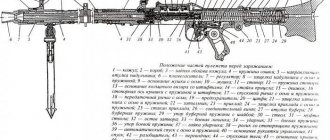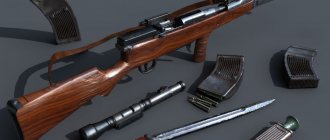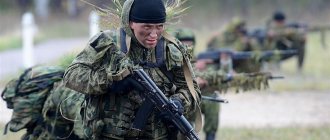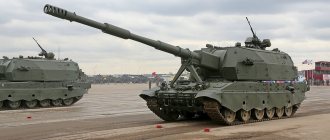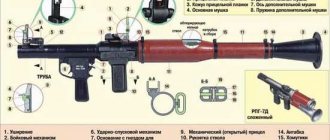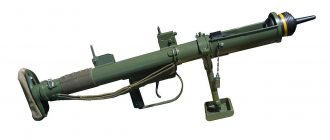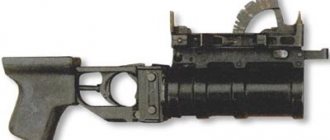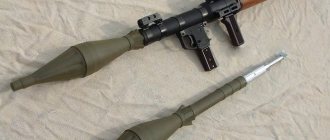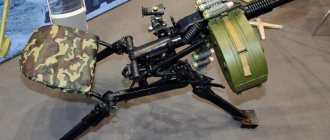GM-94 - a hand-held multi-charge grenade launcher was developed at the Tula Instrument Design Bureau in the early 1990s. The main purpose of the new weapon was to provide fire support for infantry in close combat, especially in the city, as well as conduct police special operations, designed to destroy manpower in urban areas, basements, fortifications, folds of terrain and in the mountains; damage to lightly armored vehicles; creating smoke screens and fires.
Description[edit | edit code]
The GM-94 hand-held multi-charge grenade launcher was developed at the Tula Instrument Design Bureau in the early 1990s. The main purpose of the new weapon was to provide fire support for infantry in close combat, especially in the city, as well as conduct police special operations, designed to destroy manpower in urban areas, basements, fortifications, folds of terrain and in the mountains; damage to lightly armored vehicles; creating smoke screens and fires. A whole range of 43-mm unitary rounds was developed specifically for the GM-94, including high-explosive non-fragmentation grenades, tear gas grenades, and rubber “bullet” rounds. Of particular interest are high-explosive ammunition that has thermobaric equipment with a high specific mass of explosive to the mass of the shot. This is achieved through the use of a plastic grenade body. This unusual decision was made to ensure the safe use of a grenade launcher at minimum ranges, preventing the shooter from being hit by fragments of his own grenade. The zone of destruction of enemy personnel by the high-explosive effect (shock wave, high temperature) of a thermobaric charge has a radius of up to 3 meters, and the minimum (conditionally) safe firing distance is only 5 meters. The mass of the VGM-93 thermobaric (high-explosive) grenade is about 250 g, of which 160 g is the explosive charge. The initial speed of the grenade is about 85 m/s.
It was developed for arming special forces of the Ministry of Internal Affairs.
GM-94: design and significance for domestic special forces
A distinctive characteristic of the Russian military-industrial complex since the times of the USSR was that it responded quickly and effectively to the demands of our time. Tragic mistakes in combat are considered the most valuable experience. A striking example is the history of the GM-94.
RPG rocket launchers, created in the Soviet Union after the Great Patriotic War, were very powerful, but not invincible weapons. But technological progress does not stand still. Soon RPGs became useless.
Tula grenade launcher for special forces
A huge scattering of fragments, a strong high-explosive effect, a very dangerous jet stream flying from the barrel of a grenade launcher - all of these factors made the model a threat to both enemies and weapon owners.
In addition, Cold War combat experience demonstrated that RPGs were poorly suited to street fighting. The fact is that its ammunition, equipped with a special fuse, often did not detonate when hitting targets at a short distance.
The Red Army soldiers and special forces were helped out by the GP-25 underbarrel grenade launcher. However, this weapon had a significant drawback - a weak level of firepower for a model of the corresponding category. It was hard for Russian military personnel during the conflict in Ichkeria, where the lack of such a grenade launcher had an extremely negative impact on the situation.
The latest model in the series of grenade launchers for street fighting was the GM-94. The grenade launcher was developed by experts from the Instrument Design Bureau named after. Academician Shipunov (JSC KBP) in Tula. Currently, the weapon is considered one of the most powerful representatives of its class for mounted fire in street battles. The GM-94 has a caliber of 43 mm and is capable of firing various types of projectiles. The design of the model is similar to a shotgun.
An interesting distinctive feature of the grenade launcher’s structure is that the weapon’s barrel is located not above, but below the container with shells. The GM-94 has a loading principle, like a shotgun, with a folding stock. The mass of the model without shells is 5 kg.
Although this structure looks unusual, it makes sense - it is all that is required to reduce muzzle flip and recoil during a salvo. The grenade launcher is efficient and simple. The GM-94 has only a mechanical fuse.
Widely used by FSB
Currently, the weapon is in service with the special forces of the police and the FSB. The model is designed for street battles. The grenade launcher's parameters make it possible to shoot even inside a building. In other words, the GM-94 allows you to solve many problems. So, if you put rubber shells in a weapon, you can use them to knock down a door. The grenade launcher is capable of firing gas, flash-noise, high-explosive, thermobaric and other types of grenades.
Subscribe to the Military Observer channel in Yandex.Zen
News Media2
Device[edit | edit code]
The design of the grenade launcher is a repeating weapon with pump-action reloading using a barrel that moves back and forth. A tubular magazine holding three grenades is located above the barrel. To recharge it, there is a charging window on the upper surface of the receiver, covered with a hinged lid. The bolt mirror is stationary; the coupling of the forward-moving barrel with the bolt is ensured by two hooks on the sides of the breech of the barrel. Spent cartridges are ejected downward. The trigger mechanism is self-cocking. There is a safety catch on the left side of the receiver. The folded shoulder rest serves as a handle for carrying the grenade launcher. The stock can be metal, folding upward, or a fixed skeletal design made of plastic.
The following types of grenades are used for firing from the GM-93/94: high-explosive, thermobaric, cumulative, fragmentation, illumination, gas, signal, marker with a rubber element.
Grenade launcher "GM-94"
| GM-94 in combat position |
GM-94 with a folded stock and a barrel open for reloading
The GM-94 hand-held multi-shot grenade launcher was developed at the Tula Instrument Design Bureau in the early 1990s.
The main purpose of the new weapon was to provide fire support for infantry in close combat, especially in the city, as well as to conduct police special operations.
The design of the grenade launcher is based on the design of the Lynx pump-action shotgun (also developed by KBP) with reloading by moving the barrel. The active firing principle allows you to safely fire from confined spaces.
GM-94 when firing
According to the design, the GM-94 grenade launcher is a repeating weapon with manual reloading using a fore-end that moves back and forth, connected to a movable barrel. Although the pump-type muscular drive (movement of the barrel back and forth) reduces the maximum possible rate of fire, this is not significant in a weapon of such a large caliber, but the reliability of action with a muscular drive naturally increases.
A tubular magazine holding 3 grenades is located above the barrel. To recharge it, there is a charging window on the upper surface of the receiver, covered with a hinged lid.
| Caliber, mm | 43 |
| Length (stock folded/unfolded), mm | 540 / 810 |
| Weight without grenades, kg | 4.5 |
| Magazine capacity, no. pomegranate | 3-4 |
| Initial speed, m/s | 100 |
| Sighting range, m | 300 |
| Maximum range, m | 600 |
The bolt mirror is stationary; the coupling of the forward-moving barrel with the bolt is ensured by two hooks on the sides of the breech of the barrel. Spent cartridges are ejected downward.
The trigger mechanism is self-cocking, which increases the safety of its use in a loaded state (a cartridge with a grenade in the chamber). The design includes a manual safety lock.
The grenade launcher has a folding stock, which also has the function of a carrying handle, which, given the fairly large mass of the weapon, undoubtedly increases the ease of transportation. The average time for transferring a grenade launcher from the traveling butt position to the combat position is insignificant and does not exceed 1-2 seconds.
GM-94 with non-lethal ammunition
A variety of 43-mm unitary rounds were developed specifically for the GM-94, including high-explosive non-fragmentation grenades, tear gas grenades, and rubber “bullet” rounds.
For firing, VGM 93 rounds of several types are used - gas (“smoking”) with an irritant formulation, shock shock with an elastic striking element, and thermobaric. A thermobaric grenade weighing 0.25 kg (shot weight 0.35 kg) is capable of hitting manpower within a radius of 3 m, equipment with an armor thickness of up to 8 mm, and is effective against wooden barriers and brickwork half a brick thick.
Of particular interest are high-explosive ammunition that has thermobaric equipment with a high specific mass of explosive to the mass of the shot. This is achieved through the use of a plastic grenade body. This unusual decision was made to ensure the safe use of a grenade launcher at minimum ranges, preventing the shooter from being hit by fragments of his own grenade. The zone of destruction of enemy personnel by the high-explosive effect (shock wave, high temperature) of a thermobaric charge has a radius of up to 3 meters, and the minimum (conditionally) safe firing distance is only 5 meters.
| GM-94 and grenades used in a grenade launcher |
The mass of the VGM-93 thermobaric (high-explosive) grenade is about 250 grams, of which 160 grams are the explosive charge. the initial speed of the grenade is about 85 m/s.
RPG LAW M72 - video
https://youtube.com/watch?v=qkS8cMmmjvQ
Modifications of the first model are still produced in the USA. It is not known for certain how the improved versions differ from the main one. There is only information that grenade launchers of models 72 and 72 A1 (previously produced) penetrate armored steel with a thickness of 250 mm to 275 mm, and new versions - 305 mm. Apparently a more powerful shaped charge grenade is used.
Single-use LAW M72 hand grenade launchers (LAW - Light Antitank Weapon) are supplied by the manufacturer complete with a grenade in the barrel and a charge. To bring the weapon into combat readiness, it is necessary to pull the outer pipe 280 mm back. The outer tube is made of fiberglass, the inner tube is made of aluminum alloy.
The barrel contains the trigger and impact mechanisms, a sighting device and a carrying handle. The sighting device consists of a frame sight installed in 25 m increments in the range from 50 to 350 m, as well as a folding diopter. Using the scale of the frame sight, the lead is determined when firing at targets moving at speeds up to 24 km/h. Moving targets can be hit at a distance of up to 150 m, stationary ones - up to 300 m. According to the manufacturer, the damaging effect of a shaped charge is possible at a distance of up to 1000 m. The grenade has a reactive powder charge, a stabilizer consisting of six elements, and an impact fuse .
